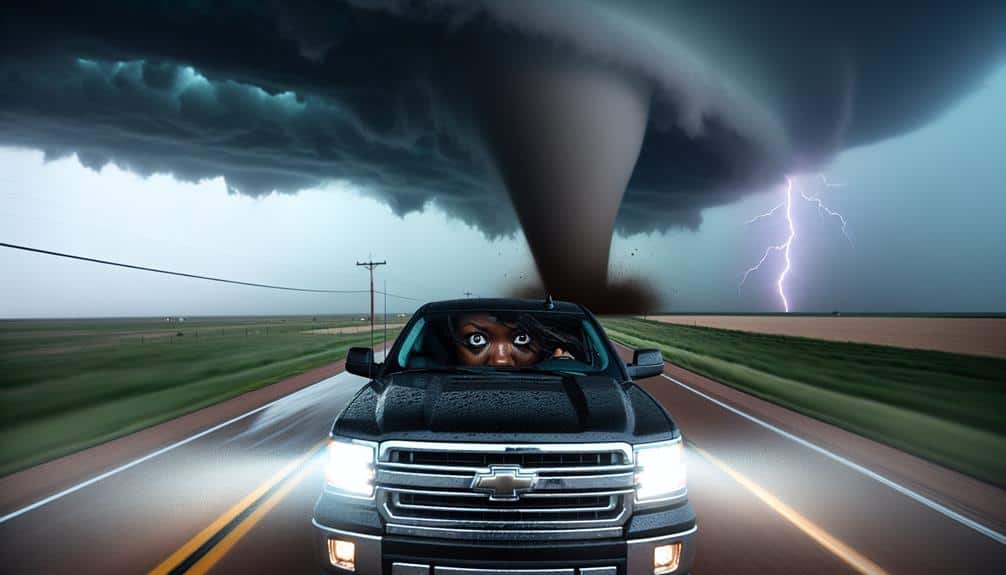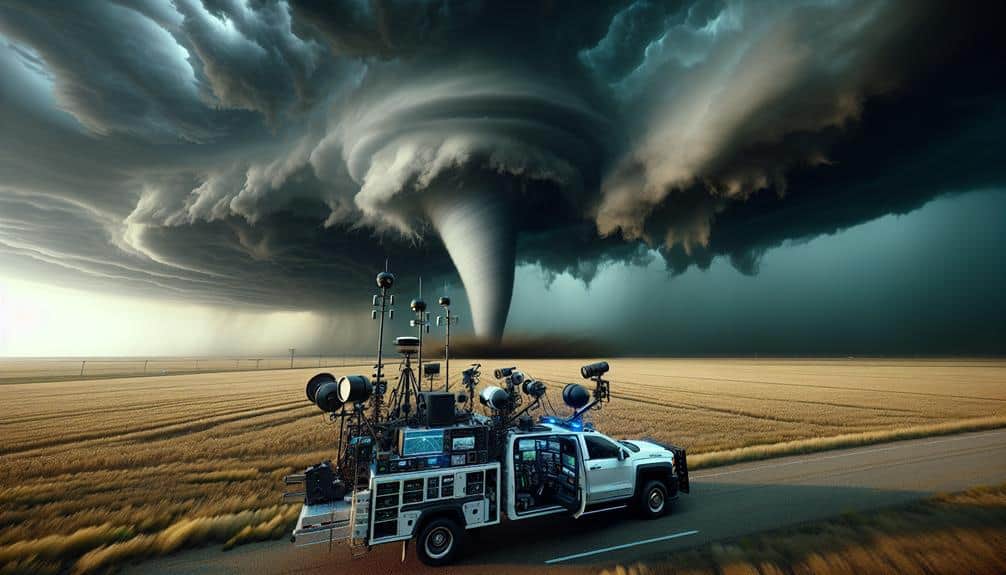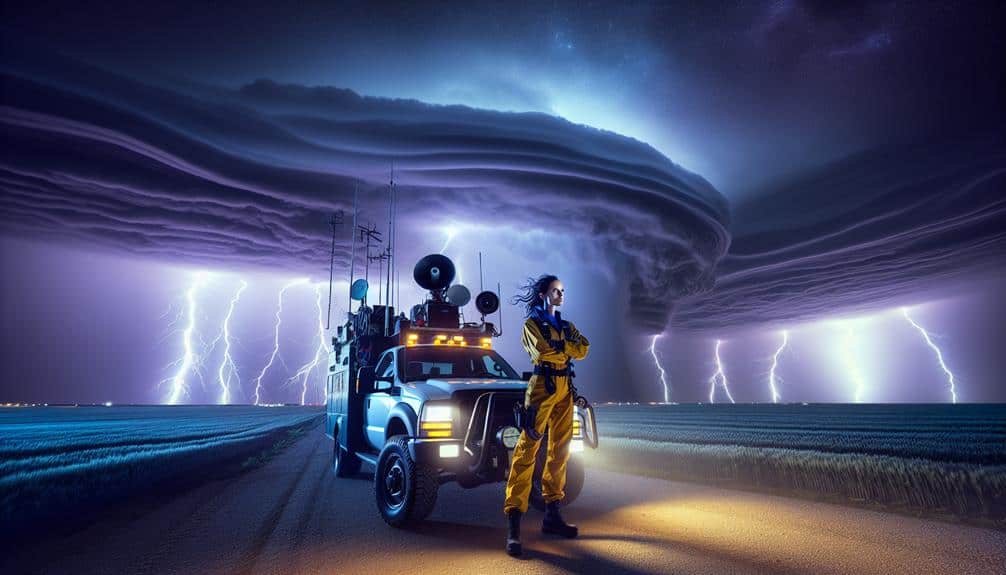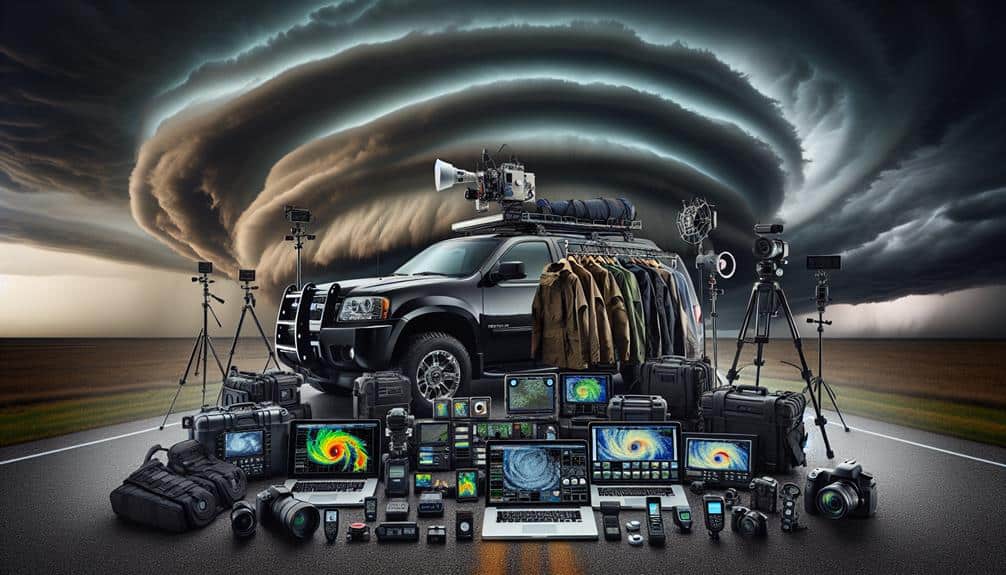We chase tornadoes because the synergy of scientific inquiry, advanced technology, and adrenal thrill drives us to face one of nature's fiercest forces. Experiencing wind speeds exceeding 300 mph exhilarates us, while cutting-edge Doppler radar and satellite data enhance our ability to predict and understand tornado dynamics. Our shared passion and high-risk endeavors foster team cohesion, while the complexity of atmospheric factors like wind shear and humidity challenges our analytical skills. This fusion of excitement and scientific pursuit offers a unique sense of control and intellectual satisfaction. Discover how we combine these elements to enhance storm chasing and deepen our understanding of tornado genesis.
Key Points
- The unparalleled thrill of experiencing nature's most violent forces drives adrenaline junkies to chase tornadoes.
- The pursuit of understanding meteorological phenomena and contributing to scientific discovery motivates tornado chasers.
- High-risk activities like storm chasing offer psychological relief and a sense of control over chaotic forces.
- Advanced technology and data analysis tools enhance the excitement and precision of tornado chasing.
The Thrill of Nature's Fury
Experiencing the raw power of a tornado firsthand, we observe wind speeds that can exceed 300 miles per hour, making these phenomena some of the most violent and unpredictable forces in nature. Our pursuit of these extreme weather events isn't just about the sheer force; it's about understanding the intricate dynamics and the thrill that comes with such risky adventures.
When we chase tornadoes, we're not just chasing the storm; we're chasing an unparalleled sense of freedom. The data gathered during these chases is invaluable. For example, Doppler radar readings during a tornado can provide insights into the storm's velocity and structure. Observing the rapid changes in barometric pressure and wind speed helps us predict the tornado's path.
Our meticulous planning includes analyzing meteorological data, understanding terrain, and ensuring safety protocols. Yet, the unpredictability of tornado movement always introduces an element of risk. It's this combination of science and the unknown that fuels our adrenaline.
We don't just see a tornado; we feel the vibrations, hear the deafening roar, and witness debris being catapulted at astonishing speeds. These risky adventures are a testimony to our relentless pursuit of knowledge and the ultimate expression of our desire for freedom.
The Science Behind the Chase
Understanding the complex meteorological factors that give rise to tornadoes is fundamental to our pursuit. We analyze atmospheric instability, wind shear, and humidity levels to predict their formation and behavior. Atmospheric instability is essential. It occurs when warm, moist air rises and meets cooler, dry air. We utilize weather patterns to locate regions with significant instability, employing tools like Doppler radar and satellite imagery.
Wind shear, the variation in wind speed and direction with height, is another crucial element. It can tilt a storm, enabling it to sustain intense updrafts without collapsing. High-resolution wind data helps us pinpoint areas where shear is most pronounced, guiding our storm chasing techniques.
By mapping these dynamics, we can forecast the most likely locations for tornado genesis. Humidity levels also play a significant role. Elevated humidity in the lower atmosphere fuels the storm's updrafts and enhances its severity. We measure dew points and relative humidity to assess the potential for tornado formation.
Community and Camaraderie
When we gather as a team to chase storms, the shared passion for meteorology and the adrenaline of the pursuit fosters a unique bond among us. The sense of camaraderie is palpable, driven by our collective fascination for extreme experiences. Each member brings specialized skills, whether it's data analysis, navigation, or real-time weather interpretation, creating a synergy that enhances our overall effectiveness.
Our shared passion for storm chasing isn't just about the thrill; it's about the science. The adrenaline rush we feel when we position ourselves near a tornado is matched by the intellectual satisfaction of accurately predicting its path. This shared danger unites us, building trust and mutual respect.
According to a recent study, teams that engage in high-risk activities report 30% higher levels of cohesion compared to those in low-risk environments. This data underscores why our bonds are so strong.
The sense of community extends beyond the chase itself. Post-chase debriefings become sessions of shared learning and growth. We analyze our strategies, discussing what worked and what didn't. This iterative process not only improves our future chases but also deepens our interpersonal connections, making our community resilient and dynamic.
The Role of Technology
How has technology revolutionized our storm-chasing endeavors, enabling us to predict tornado paths with unparalleled accuracy and safety?
The advent of tech advancements in storm tracking has fundamentally altered our approach. High-resolution Doppler radar systems provide real-time data on wind velocities, helping us detect rotation within supercells earlier than ever before. This early detection is vital for issuing timely warnings and making informed decisions about when and where to chase.
Additionally, drone footage has become an invaluable asset in storm chasing. Equipped with high-definition cameras and GPS systems, drones can capture aerial views of tornadoes, providing insights into their structure and movement. This data isn't only essential for refining our predictive models but also enhances our understanding of tornado formation and behavior.
Mobile technology allows us to access and share this data instantaneously. Apps designed for storm chasers integrate radar data, satellite imagery, and GPS tracking, creating a thorough toolkit for real-time decision-making.
We can now follow tornado paths with exceptional precision, minimizing risks and maximizing our observational opportunities.
Psychological Motivations

The psychological motivations driving storm chasers are rooted in a complex interplay of thrill-seeking behavior, a deep fascination with meteorological phenomena, and the pursuit of scientific discovery.
We often find ourselves drawn to the high-stakes environment of tornado chasing, where risk assessment becomes a critical skill. The adrenaline rush we experience when venturing close to a tornado is unparalleled, feeding our inherent thrill-seeking tendencies.
Data suggests that many of us use storm chasing as a form of coping mechanism, a way to manage stress and emotional challenges. The psychological impact of engaging in such intense activities can be profound. We derive a sense of control and mastery over chaotic natural forces, which can be empowering and liberating.
This aligns with research indicating that high-risk activities can provide psychological relief and a heightened sense of freedom.
Moreover, our fascination with meteorological phenomena drives us to seek understanding and contribute to scientific discovery. The detailed analysis and data we collect during these chases are invaluable for advancing meteorological science.
Essentially, storm chasing isn't just about seeking thrills; it's about merging passion with purpose, leveraging our psychological motivations to serve a greater good.
Frequently Asked Questions
What Is the Most Dangerous Experience You've Had While Storm Chasing?
Our most dangerous experience storm chasing was a near-death encounter. The adrenaline rush surged as our survival instincts kicked in, facing intense fear. Data indicated wind speeds exceeded 150 mph, emphasizing the peril we faced.
How Do You Prepare for a Tornado-Chasing Expedition?
To prepare for a tornado-chasing expedition, we prioritize safety measures and pack an emergency kit. We rely on advanced weather tracking technology and establish a robust communication plan to guarantee real-time data and coordinated responses.
What Kind of Vehicle Modifications Are Needed for Storm Chasing?
Ironically, when we chase storms for freedom, vehicle safety is essential. We modify our cars with storm tracking tech, reinforced exteriors, and an equipment checklist including emergency protocols. Data-driven decisions guarantee our detailed analysis keeps us safe.
How Do Storm Chasers Stay Safe During Extreme Weather Conditions?
We stay safe during extreme weather by following strict safety precautions, such as monitoring real-time data and having a robust emergency response plan. Our detailed analysis of storm patterns guarantees we maintain distance and avoid high-risk zones.
What Impact Does Storm Chasing Have on Local Communities and the Environment?
Storm chasing greatly affects local communities through economic impact and community safety. Environmental damage and wildlife preservation are major concerns. Data shows increased emergency service costs and disruptions to ecosystems, highlighting the need for balanced, responsible practices.


